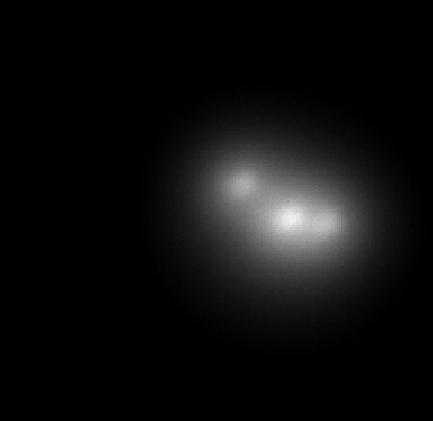SOAR Adaptive Optics Module (SAM)
Read more about NOIRLab's instruments and other capabilities in the Capabilities brochure.
Instrument Scientist: Andrei Tokovinin
CTIO & Chile Instrument Support Scientists: César Briceño, Andrei Tokovinin (Emails: firstname.lastname at noirlab.edu)
Brazilian Instrument Support Scientist: Felipe Navarete (email: firstname.lastname at noirlab.edu)
The SOAR Adaptive Module (SAM) is a laser-assisted adaptive optics system at the 4.1-m SOAR telescope. By compensating selectively low-altitude turbulence sensed by a UV laser guide-star, it improves resolution at visible wavelengths. The sky coverage is nearly full. SAM contains a 4Kx4K CCD imager covering the 3-arcmin square field and can feed light to a small visitor instrument attached to its port (Tokovinin et al. 2016).
Advantages offered by SAM. It can reach exceptionally good resolution of 0.3" or 0.4" (if the atmospheric conditions allow it) at visible and near-infrared wavelengths in a 3-arcminute field, as though the 4-m SOAR telescope was lifted halfway into space (see SAM performance). SAM is ideally suited for imaging deep-space faint targets (or narrow-band imaging) where the 4-m aperture matters. It has complete sky coverage. Compared to SOI, SAM has no gaps between CCDs and does not need mosaicing to get the continuous image. Its guiders are more sensitive than the standard SOAR guiders. SAM can be also used in open loop, without laser.
Limitations of SAM. UV light is not transmitted to the science imager, so SAM is "blind" in the U band. The correction in the B band is not so good, while the sky background in B is contaminated by the faint UV leakage of the B-filter. The SAM imager has a distortion that might affect image recombination if large dithers are used. Targets for laser operation must be defined in advance, reducing the flexibility. SAM can deliver poor resolution under unfavorable conditions.

Long-exposure images of close visual binaries reach a resolution around 0.1 arcsec in the I-band. The above image of the close triple I385 (HIP 85216) with two components at 0.39 and 0.26 arcsec, was obtained on October 2, 2009, in the I-band.
SAM is equipped with an Atmospheric Dispersion Corrector (ADC), which allows correcting for the atmosphere dispersion, especially when observing at large airmasses. It is particularly important when carrying out Speckle interferometry observations with the High Resolution Camera (HRCam). Watch this video to see the dispersion going from ZD=70[deg] to ZD=0[deg].
For further information, contact the SAM Support staff.
SAM Documentation for Users
- SAM instrument characteristics
- Filters for SAMI
- SAM User Guides and Documentation
- Observing with SAM
SAM Docs and Manuals for Support Staff
- General SAM documentation for support staff
- Uploading PAM files to the SAM Laser Clearing House (SLCH) software
- SAM Technical Manuals
- Technical Reports and Publications on SAM
- Laser Safety
- SAM Instrument Documentation (Internal Access Only)
SAM Engineering support staff
Manuel Martinez - electronics, motion control software
Rolando Cantarutti - real-time and instrument control software, HRCam
Omar Estay - SAMI software
Roberto Tighe - optics
Contact emails: firstname.lastname at noirlab.edu
Updated on January 18, 2023, 9:31 am